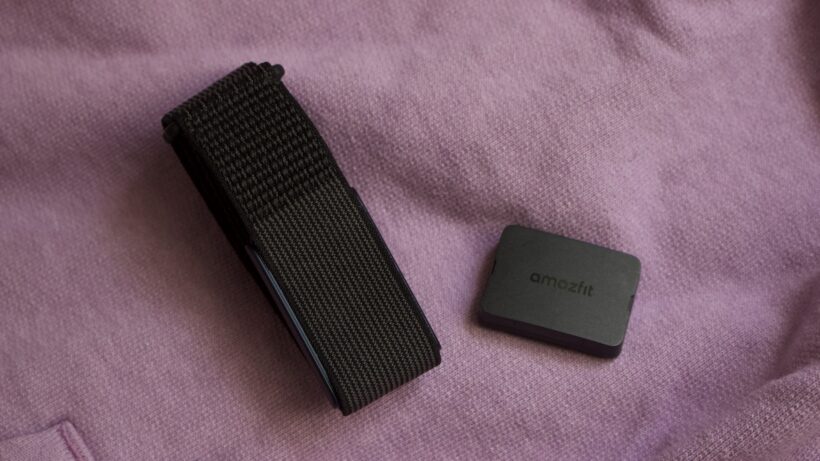A worthy, subscription-free alternative
The Amazfit Helio Strap successfully delivers on its promise to be a compelling, subscription-free alternative to Whoop. The hardware is lightweight and comfortable, while the core tracking for heart rate and sleep is impressively accurate—particularly when the sensor is worn on the upper arm. While it’s let down by unreliable automatic workout detection and a Zepp Health app that lacks the polish of its rivals, these are forgivable quirks. For anyone wanting the screenless tracker experience without the eye-watering cost, the Helio Strap is an easy recommendation.
Pros
- Can be worn on the wrist and arm (with optional arm strap)
- Good heart rate tracking accuracy across exercises
- Useful training features (though not massively original)
Cons
- Automatic exercise recognition is overly sensitive
- Zepp Health UI could be slicker
- Only available in one color
In the cutting-edge wearables industry, design trends rarely stay exclusive for long. So, given Whoop’s runaway success in the screenless fitness tracker market in recent years, it was only a matter of time before well-established brands tried to claim a share.
The Helio Strap from Amazfit is one of the first to do so, with the Polar Loop—and, to a lesser extent, the Garmin Index Sleep Monitor—following closely behind.
As you would expect, Amazfit has positioned the Helio Strap to replicate many of Whoop’s core functions. It’s a training partner, fitness tracker, and sleep monitor—and, crucially, it does so without requiring users to pay extra for access to full software features.
Given Whoop’s controversial subscription changes earlier this year, there’s certainly room for a cheaper alternative. So, does the Amazfit Helio Strap manage to do that?
After testing for the last couple of months, we can confidently say it does. Yet, it’s also not an experience without quirks.
Price and competition
The Amazfit Helio Strap is significantly less expensive than the Whoop 5.0 and Whoop MG.
It costs $99.99/£99.90, and that’s all you have to pay unless you want access to some premium features in the Zepp Health app (which are not specific to the Helio Strap). All core features are available for free.
For comparison, the Whoop costs between $199 and $359 per year, or $25 to $40 per month, including both hardware and software. No matter which way you spin it, it’s a more expensive choice.
The Polar Loop, like the Helio Strap, is another Whoop lookalike that provides free access to all available software after you pay $200/£150. Again, that’s more expensive than the Helio Strap.
You also have the Garmin Index Sleep monitor, which, as the name suggests, is made mainly for sleep monitoring and is worn only on the upper arm. That costs $170/£150.
Design and comfort

Over the years, Whoop has nailed the brief of creating a screen-free band that looks great and feels super comfortable. It means it’s truly something you can wear all the time. There are definitely similar design characteristics with the Helio Strap—and that’s a good thing.
It’s super lightweight, weighing just 20g, and the single black colorway gives it a sleek, understated look. Although it can’t track your swims, it has a 5ATM waterproof rating, ensuring it can withstand a dip.

It’s meant to be worn on your wrist, similar to a Whoop or Polar Loop. You also have the option to wear the sensor on your upper arm and improve the heart rate accuracy (as we’ll explore below), but that comes with an extra cost.
It’s easy to remove the nylon strap, which uses a simple pin mechanism at each end. There’s a combination of a loop and Velcro to fasten the strap to your wrist, which mostly stays in place but can get caught at times when pulling off clothes.
It would be nice to have a few more colors to choose from. Yet, if the goal was to create something that looks and feels like a Whoop, then Zepp Health has definitely succeeded in that area.
Battery life

Amazfit smartwatches have always impressed with their battery life, and, since there’s no display on the Helio Strap, we expected good numbers. That’s exactly what we got.
There’s a 232mAh capacity battery in the main sensor module that should last up to 10 days. Like Amazfit’s smartwatches, reaching that maximum depends on how often you track workouts or enable the most accurate sleep and health monitoring.
We found it can easily last through a week—even up to 10 days, with heavier use. What’s also great is that if you take it off for a while, it doesn’t just drain the battery during that time.
For charging, there’s a small cradle that securely clips to the back of the Strap’s sensor and charges quickly. We found it went from 0-100% in about two hours, so it’s surprisingly not the speediest charger.
For comparison, the Whoop has a maximum of 14 days of battery life, while the Polar Loop can last up to 8 days. It falls somewhere in between, so it’s competing with those two screen-free bands. Depending on how you use it, it has the potential to offer the best battery life of the current options.
Tracking and heart rate accuracy

The Helio Strap essentially tries to function like a Whoop. It can monitor your heart rate, stress, and SpO2 levels through Zepp Health’s latest BioTracker 6.0 biometric sensor. It tracks sleep and daily activity, and there are dedicated sports modes where you’ll need to use a combination of your phone and some of the onboard smart recognition technology to better track workouts.
Let’s start with heart rate accuracy, which is pretty crucial since there’s no screen here. Because of that, we were especially interested in whether it could perform like other dedicated heart rate monitors. These devices typically outperform wrist-only devices, such as smartwatches, in terms of latency and overall accuracy during high-intensity workouts and interval training.
On the Helio Strap, there’s actually also the neat touch of being able to begin workouts in a dedicated Hyrox mode.
The heart rate accuracy test

We tested the Helio Strap with a mix of indoor and outdoor workouts of different intensities, including runs, indoor rides, indoor rowing, and general strength training.
We also tracked heart rate from both the wrist and upper arm, as this can significantly impact both overall accuracy and latency. Since there is no display to look at during workouts, the latency point is only necessary to consider if you spend a lot of time tracking workout types that allow you to follow along on your phone.

In short, the heart rate sensor’s performance was excellent—particularly when tracking from the upper arm. It’s actually a shame that the Helio Strap’s Armband accessory isn’t included out of the box, because it would represent a nice win over Whoop.
Using it for specific workouts can provide very accurate heart rate readings. Even at the wrist, it performed well across various activity types.
The easiest way to summarize the results is this: when used with the Armband, the session averages and maximum readings were nearly identical (usually within 1-2 BPM) to those of our Garmin HRM 600, and differences from the wrist were approximately 3-5 BPM on some measurements. Either way, it’s highly recommended.

Automatic exercise detection
The other key aspect of tracking—since there’s no screen to select options—is the array of workout types and their automatic detection. You have 25 sports modes in total. That includes running, cycling, Hyrox (during competitions), and a wide range of indoor workouts. These include strength training, HIIT, and the Elliptical. It’s a nice touch that, to add more strength training options, it can recognize 25 different movements.
There are two main ways to track a workout. You can rely on the automatic exercise recognition, or manually track it using the app. The sensitivity of the exercise recognition is high, though, and we found in testing that it often fails to identify many workouts correctly. For example, it sometimes confuses slightly brisk walks with workouts. While it’s helpful that you can adjust the sensitivity in the app—even then, it still tends to pick up activities that aren’t actually exercises.
As a result, we turned off that mode and relied on manual tracking from the app. It worked fine for most workouts, but it would be useful to stop tracking directly from the band—either with a tap or a button, to avoid having to go back to the app to end it. Many times, we forgot to do that, and it recorded a very long workout.

Outside of exercise tracking, this is a wearable that does reliably monitor steps, sleep (more on that below), blood oxygen levels, temperature and stress. Switching on the continuous blood oxygen and stress monitoring will have a notable impact on battery life however.
Training insights and sleep tracking

The comparisons between Whoop and the Helio Strap continue when you explore the extra metrics and insights Helio provides, which aim to help you better understand your exercise and its effects on your fitness levels and overall well-being.
On the performance side, there are some familiar sports watch metrics. It tracks your VO2 max and suggests recovery times based on the intensity and duration of the workout. It also records your current training load and provides training effect insights to help you understand if your training is positively or negatively impacting your progress—similar to what you’ll find on Garmin.

Unique to the Helio Strap is Zepp Health’s BioCharge metric, which functions similarly to Garmin’s Body Battery energy monitor. It scores you based on sleep quality and data like stress, exercise, and rest to help you make better decisions for the day and maybe when to go to bed.
The sleep-powered insights
In addition to the main BioCharge metric, there is also a Wake BioCharge metric, which is similar to Oura, Google, and Garmin’s readiness insights. These are powered by sleep data, including heart rate variability measurements and workouts from the past three days.

The key is to establish your baseline, which requires wearing and collecting the Helio Strap for 7 days. Before that, it’s simply based on the average data from other users.
Once you complete that baseline, the BioCharge energy monitor and wake data tend to mirror what similar features from Garmin and Oura have suggested. When we have a tough workout or a bad night’s sleep, the Biocharge scores tend to reflect it.

With the Wake scores, this depends heavily on the Helio Strap accurately tracking your sleep. We’ve tested it in bed with the Oura Ring 4 and other reliable sleep trackers, and the Helio Strap performs well for core sleep statistics.
It’s a similar story when looking at fitness stats like VO2 max and data such as fatigue levels and fitness level graphs. These insights are meant to provide guidance and will definitely help many.
Zepp Health app

For wearables without screens, the best companion apps show your progress in a way that strikes a balance between data and readability. In Zepp Health’s case, we think there’s still room for improvement in finding that balance.
The main home screen is where you’ll find details of your core metrics. There’s a dedicated tab for Zepp Health’s BioCharge metric, as well as sleep and exertion data. The latter displays information such as fatigue level, current fitness level, and your training status.
There’s a lot of data to fit in, similar to other screen-less wearables like smart rings and Whoop. The app’s UI has some elements that could be simplified further, and removing some clutter would help make it more streamlined.

A good example of this is the workout section of the app, where you’ll see workout history, training plan, a manual workout section, and training insights. Even just listing these gives you a sense of how much is packed into these pages.
Zepp Health has moved quickly to ensure that your data doesn’t just stay in its own app. You can sync data to display in Strava and Adidas Running, and it even supports the popular training app TrainingPeaks. It transfers data to Apple Health and Google Fit, too.
There are elements of this companion app that work, and elements that don’t. It’s significantly better than it was a few years ago, but it’s still not quite on par with Oura or Whoop’s companion apps. It’s a key area where you still generally get what you pay for in the wearables world.





